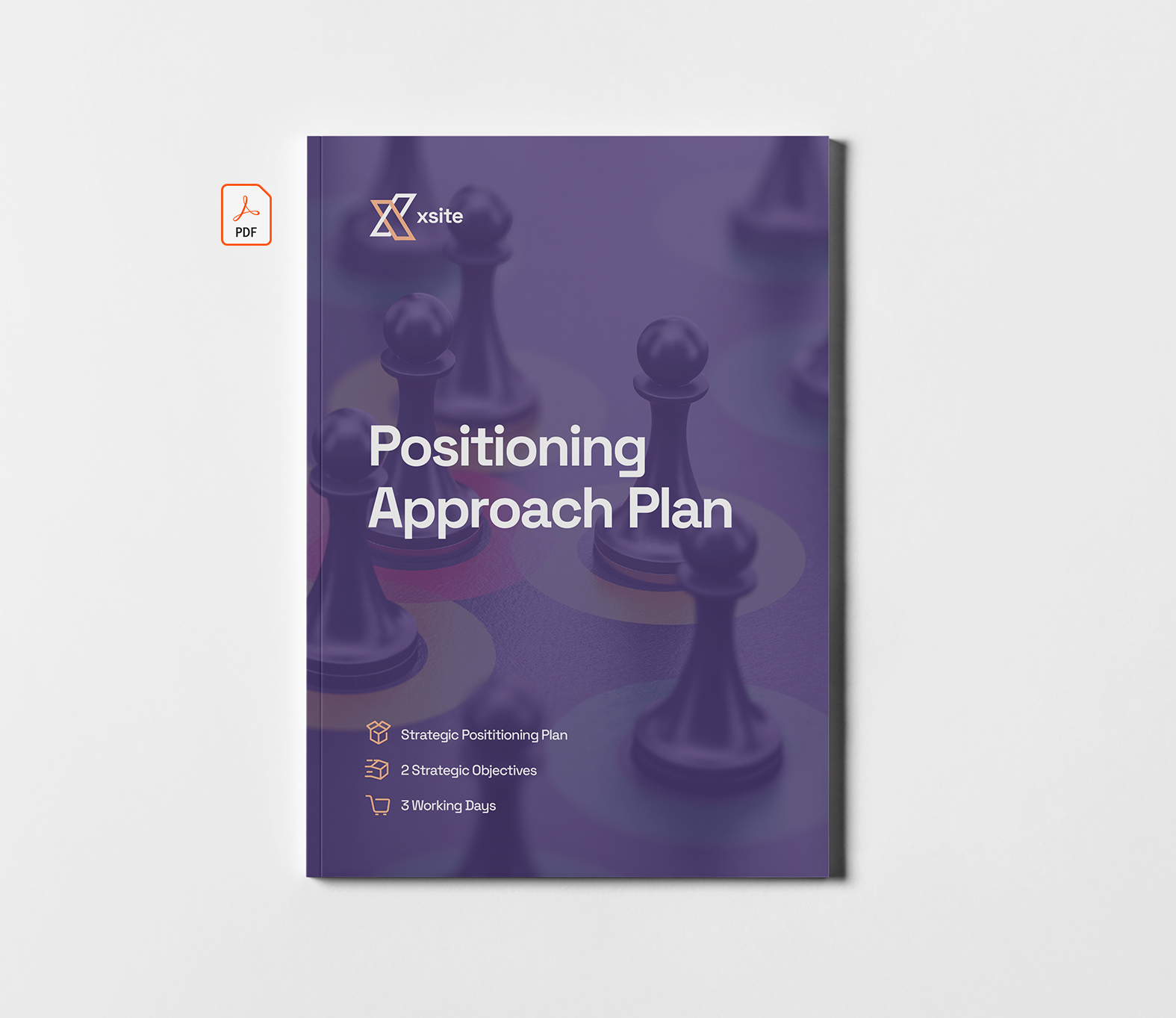Efficiency
start here.
Give customers Brand they desire,
build an Enterprise you want to run.

Based on cutting-edge technologies, followed by world-class brands






Perform Quantitative Market Research
Define
Market Size
Competitive positioning is about defining how you’ll differentiate your offering and create value for your market. It’s about carving out a spot in the competitive landscape and focusing your company/product/service to deliver on that strategy. Your ultimate goal is to win mindshare in the market — to be known as a “certain something” in the market’s mind.
Learn the Number of Total
Potential Customers in Market
Your goal is to make your market profile as complete as possible.
Understand the Typical
Company / Customer Profile
What does a typical company or customer look like in your market?
Learn the Total
Annual Sales for Market
What are the total annual sales (revenue) for the product or service in your market?
Learn the Commonalities
Among Typical Customers
What do your target customers have in common?
Learn the Geographic Location of Customers Within Market
Are they local, regional, national or international?
Learn the Number of Companies
/ Products Available in Market
How many companies/products are already selling into the market?

Outline Market Characteristics
After you’ve defined your market size, begin outlining your market’s characteristics. For this task we highly recommended that you have at least one person involved who intimately knows your market and customers. You’ll want to describe what’s currently happening in your market and the influences on the market.
Figure out the Current
Market Characteristics
What are the characteristics of your market? Is it growing, stable or contracting?
Figure out the Current
Influences on Market
What's currently influencing your market?
Figure out the Decision
Maker + Influencer
Who makes the ultimate decision to buy from you? Who else is involved in the buying decisions (the "influencers")?
Figure out the
Knowledge of Pain
Is your market actively seeking a solution to this problem?
Figure out the
Market Trends
Finally, what are the trends in your industry and/or market?

Select
Positioning Approach
It’s important to understand the lifecycle stage of your market. The market’s maturity impacts how you should approach your market and position your company/product/service against your competitors. Reference the market data and market characteristics to help determine the lifecycle stage if it’s not apparent.
Determine the
Lifecycle Stage
The market's maturity impacts how you should approach your market and position your company/product/service against your competitors.
Select Positioning
Approach
Now it's time to put everything together to determine your high-level approach to positioning yourself in the market.

00%
Successmeter
Perform Qualitative Market Research
Qualitative market research will help us understand the behaviors, attitudes and decision-making processes of customers and prospects in our markets. These are the psychographics of our market. By understanding how our customers and prospects think – knowing what their true problems are, how they attempt to solve them and how we fit into their solution – we’ll better understand how to fulfill their needs and market to them. This understanding will also help us define market segments or personas – the distinct subgroups of our market – that will allow us to more efficiently market to each group.

Understand
Market Pains
How well do you really know your customers and your target market? Your goal is to understand how your prospects & customers think. What are their true problems, and how do they attempt to solve them?
There are many ways to accomplish this. Your approach is probably dependent upon your current market intelligence, your available resources and your urgency for creating a competitive positioning and brand strategy.
Select Market
Research Method
Data Collection Options: Poll customers, Poll lost prospects, Use a focus group, Use a market research firm.
Define Market
Research Sample Size
In market research, sampling means getting opinions from a number of people, chosen from a specific group, in order to find out about the whole group.
Examine
Sample Responses
After you've reviewed your results, consider them carefully and summarize your findings.
Analyse
Market Research
Read through it carefully, and take your time to capture the essence of what your market is telling you.

Defining
Market Segments
When you segment your market or create buyer personas, you can do a better job addressing the specific problems faced by the people/companies/prospects within each segment. And when you speak to specific problems and needs, you can greatly improve all of your sales and marketing efforts.
Evaluate the
Issue/Challenge Categories
Consider the market feedback and evaluate the problems, pains or challenges that your customers and prospects face.
Evaluate the
Companies/People Categories
Now, think about the issues you listed above and the companies/people that fall into those categories.
Determine
Segmentation Criteria
Product Usage Criteria + Demographics Criteria + Persona Criteria
Define Market
Segmentation Criteria
It's a good idea to revisit the pains the people in your market face before you determine your segmentation criteria.
Profile Your
Customer Segments
The final step is to create and profile each segment or persona.

00%
Successmeter
It is impossible to Outline the Characteristics of your Target Audience without Defining your Market Size
Perform Qualitative
Market Research
Qualitative market research will help you understand the behaviors, attitudes, and decision-making processes of customers and prospects in your markets. These are the psychographics of your market. By understanding how your customers and prospects think – knowing what their true problems are, how they attempt to solve them and how you fit into their solution – you’ll better understand how to fulfill their needs and market to them.

Figure out the Current Market Characteristics
What are the characteristics of your market? Is it growing, stable or contracting? Are prospects actively seeking out your product/service? Do they have a known pain but not yet realize that your product/service will alleviate that pain?
Figure out the Current
Influences on Market
What's currently influencing your market? Are there any new developments affecting it, such as legislation, social trends or new technological breakthroughs that are creating urgency?
Figure out the Decision
Maker + Influencer
Who makes the ultimate decision to buy from you? B2B marketers often have to deal with multiple decision-makers or a team of decision-makers and a number of influencers. This affects their overall marketing and sales strategy, as they often have to deliver different messages to different people within a company.
It's typically clearer for consumer marketers, as the person using the product/service is often the decision-maker. However, many big-ticket items, such as cars, furniture, and appliances, may have multiple decision-makers.
Who else is involved in the buying decisions (the "influencers")?
Figure out the Knowledge of Pain
Is your market actively seeking a solution to this problem? In B2B, for most companies, there is a mix of people actively seeking a solution, people wanting a solution if one were to be presented to them (but they're not actively seeking one), and people who have the pain (whether they've realized it or not). B2C is similar. For example, for cold medicine, the buyers have pain (a cold) and are actively seeking a solution. For a teeth whitener, many people in the market might not be actively seeking the product but might be interested if it was affordable, easy, and effective. People with stained teeth, who have no interest in breaching them, would have pain, but wouldn't desire a solution. People with naturally white teeth would have no pain.
These scenarios affect the marketing strategy and ultimate positioning, as markets with a high number of prospects actively seeking a solution require different activities than does a market with a large number of prospects who have latent or unknown pain.
Estimate the percentages of each scenario. If you don't know, start with a guess, and refine it as you are able. All four combined should total 100%.
1) Percentage Mix of People/Companies Actively Seeking a Solution in the Market:
2) Percentage Mix of People/Companies Desiring a Solution in the Market:
3) Percentage Mix of People/Companies with a Pain but Not Desiring a Solution in the Market:
4) Percentage Mix of People/Companies with No Pain in the Market
Figure out the Market Trends
Finally, what are the trends in your industry and/or market? Trends are important because they can translate into new opportunities. For example, is the industry shifting toward a new type of solution? A current popular trend is "green" products. Many consumers are willing to pay more for a product that they believe is friendly to the environment. You may have already listed your trends above under "Characteristics or Influences," which is fine, but it's possible that all three -- characteristics, influences and trends -- could be different.
00%
Closer to the Dream
It is impossible to Select Positioning Approach without Outlining Market's Characteristics
Select Positioning Approach
Now it’s time to put everything together to determine your high-level approach to positioning yourself in the market. Review the characteristics of your lifecycle stage and the typical positioning approach for each below. You may decide that the typical positioning approach is right for you, or you may wish to modify it.

Determine the Lifecycle Stage
(per product / market)
Select Positioning Approach
(per product / market)
00%
Closer to the Dream
Understand Market Pains
Now it’s time to put everything together to determine your high-level approach to positioning yourself in the market. Review the characteristics of your lifecycle stage and the typical positioning approach for each below. You may decide that the typical positioning approach is right for you, or you may wish to modify it.
Select Market Research Method
Define Market Research Sample Size
Examine Sample Responses
Analyse Market Research
00%
Closer to the Dream
Define Market Segments/Personas
Now it’s time to put everything together to determine your high-level approach to positioning yourself in the market. Review the characteristics of your lifecycle stage and the typical positioning approach for each below. You may decide that the typical positioning approach is right for you, or you may wish to modify it.
Evaluate Issue/Challenge and Companies/People that Fall into Category
Determine Segmentation Criteria
Define your customer segments
Profile your customer segments
00%
Closer to the Dream
Research Competition
Now it’s time to put everything together to determine your high-level approach to positioning yourself in the market. Review the characteristics of your lifecycle stage and the typical positioning approach for each below. You may decide that the typical positioning approach is right for you, or you may wish to modify it.
List your top five direct competitors
List your top five indirect competitors
List your top five future competitors
Create a final competitor list
00%
Closer to the Dream
Evaluate Competition
Now it’s time to put everything together to determine your high-level approach to positioning yourself in the market. Review the characteristics of your lifecycle stage and the typical positioning approach for each below. You may decide that the typical positioning approach is right for you, or you may wish to modify it.
Determine the comparison criteria to use
Rate competitors and yourself based on the criteria
Evaluate your ratings
Synthesise into a SWOT Analysis: Strengths: What We Do Well
Synthesise into a SWOT Analysis: Weaknesses: What We Do Poorly
Synthesise into a SWOT Analysis: Opportunities: Available Potential
Synthesise into a SWOT Analysis: Threats: Obstacles in Our Path
00%
Closer to the Dream
Define Value Proposition
Now it’s time to put everything together to determine your high-level approach to positioning yourself in the market. Review the characteristics of your lifecycle stage and the typical positioning approach for each below. You may decide that the typical positioning approach is right for you, or you may wish to modify it.
Select Primary Value Proposition
Select Secondary Value Proposition
Understand the Value Propositions of your Competitors in the Marketplace
Rate Competitors Ability to Deliver upon each of these Value Propositions
Analyse Problems our Competitors Are Solving Effectively
Analyse Problems our Competitors Aren't Solving Effectively
Rethink Opportunities
Readjust Value Proposition
00%
Closer to the Dream
Create Competitive Positioning Matrix
Now it’s time to put everything together to determine your high-level approach to positioning yourself in the market. Review the characteristics of your lifecycle stage and the typical positioning approach for each below. You may decide that the typical positioning approach is right for you, or you may wish to modify it.
Create a Competitive Positioning Matrix for Market One
Create a Competitive Positioning Matrix for Market Two
Create a Competitive Positioning Matrix for Market Three
Create a Competitive Positioning Matrix for Market Four
00%
Closer to the Dream
Define Competitive Positioning & Strategy
Now it’s time to put everything together to determine your high-level approach to positioning yourself in the market. Review the characteristics of your lifecycle stage and the typical positioning approach for each below. You may decide that the typical positioning approach is right for you, or you may wish to modify it.
Decide ≪Market Mindshare≫ competitors currently own
Decide ≪Market Mindshare≫ would you like to own
Define Long-Term Mindshare Goal
Write Long-Term Competitive Positioning Strategy
00%
Closer to the Dream
Determine the Basics for the Foundation of Your Brand
Now it’s time to put everything together to determine your high-level approach to positioning yourself in the market. Review the characteristics of your lifecycle stage and the typical positioning approach for each below. You may decide that the typical positioning approach is right for you, or you may wish to modify it.
Choose Brand Type to Use
Confirm Primary Value Proposition
Confirm Secondary Value Proposition
Identify Brand Themes to Explore
00%
Closer to the Dream
Explore Brand Emotional Benefits
Now it’s time to put everything together to determine your high-level approach to positioning yourself in the market. Review the characteristics of your lifecycle stage and the typical positioning approach for each below. You may decide that the typical positioning approach is right for you, or you may wish to modify it.
List the Features and Benefits of your product/service
Determine whether each Benefit is Functional or Emotional
Explore the Emotional Benefits of your Brand
Determine how Important each Feature and Benefit is to your Customers
00%
Closer to the Dream
Select Brand Pillars
Now it’s time to put everything together to determine your high-level approach to positioning yourself in the market. Review the characteristics of your lifecycle stage and the typical positioning approach for each below. You may decide that the typical positioning approach is right for you, or you may wish to modify it.
Rate your Features and Benefits
Evaluate Rated Features and Benefits
Choose a Single "level of importance" for each Feature and Benefit type
Determine Features and Benefits that connect most strongly with your market's emotions
Test Your Brand Pillars
00%
Closer to the Dream
Determine Brand Means
Now it’s time to put everything together to determine your high-level approach to positioning yourself in the market. Review the characteristics of your lifecycle stage and the typical positioning approach for each below. You may decide that the typical positioning approach is right for you, or you may wish to modify it.
Brainstorm Brand Means
Review Brand Pillars
Evaluate Potential Brand Means
Choose Top Three Brand Means
00%
Closer to the Dream
Select Brand Personality Traits
Now it’s time to put everything together to determine your high-level approach to positioning yourself in the market. Review the characteristics of your lifecycle stage and the typical positioning approach for each below. You may decide that the typical positioning approach is right for you, or you may wish to modify it.
Define the High-Level Personality Category for Your Brand
Identify Five Brand Values that Describe the Way You Want the Market to View Your Brand
Identify Five Brand Strengths that Describe the Way You Want the Market to View Your Brand
Identify Five Brand Unique Attributes that Describe the Way You Want the Market to View Your Brand
Identify Fourth Human Trait that Describe the Way You Want the Market to View Your Brand
00%
Closer to the Dream
Determine Brand Promise
Now it’s time to put everything together to determine your high-level approach to positioning yourself in the market. Review the characteristics of your lifecycle stage and the typical positioning approach for each below. You may decide that the typical positioning approach is right for you, or you may wish to modify it.
Determine your Brand Promise
Determine your Brand Vision
Determine your Brand Archetype
Determine the Brand Promise for your Top 5 Competitors
Review the Competitors'Promises
Rank the Most Valuable Promises to the Market
00%
Closer to the Dream
Create Brand Positioning Statement
Now it’s time to put everything together to determine your high-level approach to positioning yourself in the market. Review the characteristics of your lifecycle stage and the typical positioning approach for each below. You may decide that the typical positioning approach is right for you, or you may wish to modify it.
Wordsmith 25-Word Brand Positioning Statement
Define 25-Word Brand Positioning Statement Evaluation Criteria
Evaluate your 25-Word Brand Positioning Statement by Criteria
Finalise your 25-Word Brand Positioning Statement
00%
Closer to the Dream
Write Brand Story
Now it’s time to put everything together to determine your high-level approach to positioning yourself in the market. Review the characteristics of your lifecycle stage and the typical positioning approach for each below. You may decide that the typical positioning approach is right for you, or you may wish to modify it.
Brainstorm the Credibility, Differentiation, Purpose, Intrigue and personality
Record Brand Story Ideas
Evaluate Brand Story Ideas
Craft your compelling story that will endure for five to ten years
00%
Closer to the Dream
Select Brand Name
Now it’s time to put everything together to determine your high-level approach to positioning yourself in the market. Review the characteristics of your lifecycle stage and the typical positioning approach for each below. You may decide that the typical positioning approach is right for you, or you may wish to modify it.
Brainstorm a Brand Name to Use
Evaluate a Brand Name to Use
Confirm a Brand Name to Use
Copyright your Brand Name
00%
Closer to the Dream
Evaluate Visual Branding
Now it’s time to put everything together to determine your high-level approach to positioning yourself in the market. Review the characteristics of your lifecycle stage and the typical positioning approach for each below. You may decide that the typical positioning approach is right for you, or you may wish to modify it.
Evaluate the Relevance are your Brand Visuals (to your Brand Strategy and Promise)
Evaluate the Quality of your Brand Visuals
Evaluate the Consistency of your Brand Visuals
Evaluate the Identity Needs
Write Identity Style Guide
Evaluate the Print & Digital Needs
Write Print & Digital Style Guide
Evaluate Marketing Campaign Needs
Write Marketing Campaigns Style Guide
Evaluate Retail Location Needs
Write Retail Location Style Guide
Evaluate Employee Location Needs
Write Employee Location Style Guide
00%
Closer to the Dream
Design a Brand Visual identity
Now it’s time to put everything together to determine your high-level approach to positioning yourself in the market. Review the characteristics of your lifecycle stage and the typical positioning approach for each below. You may decide that the typical positioning approach is right for you, or you may wish to modify it.
Choose Brand Colour Palette
Choose Brand Typography Set
Discover a Brand Symbol
Design a Brand Logo
Set-up Marketing Digital Asset Management Service
00%
Closer to the Dream
Define Brand Operational Requirements
Now it’s time to put everything together to determine your high-level approach to positioning yourself in the market. Review the characteristics of your lifecycle stage and the typical positioning approach for each below. You may decide that the typical positioning approach is right for you, or you may wish to modify it.
List all inbound "Touch Points" with your market
Determine if a given "Touch Point" Supports your Brand and Brand Promise
Explain Operational Touch Point and an Improvement to Implemented
Summarise all Touch Points into Succinct Operational Branding Requirements
00%
Closer to the Dream
Determine If a New Distribution Channel Is Right for You
Now it’s time to put everything together to determine your high-level approach to positioning yourself in the market. Review the characteristics of your lifecycle stage and the typical positioning approach for each below. You may decide that the typical positioning approach is right for you, or you may wish to modify it.
Define what are the most important goals for you?
Understand the potential positives to creating a new channel
Understand the potential downsides to creating a new channel
Decide to pursue a new distribution channel or not?
00%
Closer to the Dream
Evaluate an Existing Distribution Channel
Now it’s time to put everything together to determine your high-level approach to positioning yourself in the market. Review the characteristics of your lifecycle stage and the typical positioning approach for each below. You may decide that the typical positioning approach is right for you, or you may wish to modify it.
Name your Existing Channel
Describe your Existing Channel
Identify an Existing Distribution Channel Areas that are Working Well
Identify an Existing Distribution Channel Areas Needing Improvement
Decide to improve an Existing Distribution Channel or not
00%
Closer to the Dream
Establish Distribution Goals
Now it’s time to put everything together to determine your high-level approach to positioning yourself in the market. Review the characteristics of your lifecycle stage and the typical positioning approach for each below. You may decide that the typical positioning approach is right for you, or you may wish to modify it.
Define What your End-Users Need and How you Would Expect a Channel to Work
Record Important Elements to Address in a Potential New Distribution Channel
Determine your Distribution Channel Goals (start high)
00%
Closer to the Dream
Select Channel Type
Now it’s time to put everything together to determine your high-level approach to positioning yourself in the market. Review the characteristics of your lifecycle stage and the typical positioning approach for each below. You may decide that the typical positioning approach is right for you, or you may wish to modify it.
Study Distribution Channel Types
Evaluate selected Distribution Channel Types
List Examples in your Industry of Chosen Types
Consider Vertical vs Horizontal Distribution Strategy
00%
Closer to the Dream
Project Channel Revenue
Now it’s time to put everything together to determine your high-level approach to positioning yourself in the market. Review the characteristics of your lifecycle stage and the typical positioning approach for each below. You may decide that the typical positioning approach is right for you, or you may wish to modify it.
Project the Revenue the Channel Could Potentially Generate
Estimate the Number of Channel Partners in months 1-3, 4-6, 7-9, 10-12
Estimate an Average per-unit Revenue when Selling to an Average Channel Partner
Estimate the number of Units an Average Channel Partner Could Sell per Month
00%
Closer to the Dream
Design Channel
Now it’s time to put everything together to determine your high-level approach to positioning yourself in the market. Review the characteristics of your lifecycle stage and the typical positioning approach for each below. You may decide that the typical positioning approach is right for you, or you may wish to modify it.
Name Distribution Channel to Create
Define Distribution Channel Purpose
Map the Steps Involved in Reaching your End-User
Outline Potential Channel Structure
Analyse Channel Logistics
00%
Closer to the Dream
Find Channel Partners
Now it’s time to put everything together to determine your high-level approach to positioning yourself in the market. Review the characteristics of your lifecycle stage and the typical positioning approach for each below. You may decide that the typical positioning approach is right for you, or you may wish to modify it.
Choose a Channel Type to Target
Figure out Channel Partners Key Criteria
Describe Your Ideal Channel Partner
Research Channel Partner
Prepare Sales Pitch
00%
Closer to the Dream
Create Channel Partner Management Plan
Now it’s time to put everything together to determine your high-level approach to positioning yourself in the market. Review the characteristics of your lifecycle stage and the typical positioning approach for each below. You may decide that the typical positioning approach is right for you, or you may wish to modify it.
Determine your Channel Manager
Outline your Channel Risks
Address each Area Requiring Management
Outline your Channel Requirements
List your Requirements for each Channel Management Area
00%
Closer to the Dream
Minimise Channel Pricing Conflict
Now it’s time to put everything together to determine your high-level approach to positioning yourself in the market. Review the characteristics of your lifecycle stage and the typical positioning approach for each below. You may decide that the typical positioning approach is right for you, or you may wish to modify it.
Choose Channel Market Penetration Method
Outline Potential Challenges to Your Distribution Channel
Outline Potential Solutions to Your Distribution Channel
00%
Closer to the Dream
Determine Channel Markups
Now it’s time to put everything together to determine your high-level approach to positioning yourself in the market. Review the characteristics of your lifecycle stage and the typical positioning approach for each below. You may decide that the typical positioning approach is right for you, or you may wish to modify it.
Evaluate the Market and Your Competitors' Prices
Determine Your Price Floor
Determine Price Markups at Each Step
00%
Closer to the Dream
Set Channel Pricing
Now it’s time to put everything together to determine your high-level approach to positioning yourself in the market. Review the characteristics of your lifecycle stage and the typical positioning approach for each below. You may decide that the typical positioning approach is right for you, or you may wish to modify it.
Finalise Your Inputs
Analyse Cost of Goods Data
Analyse Desired Profit Margin
Define Suggested Channel Price
00%
Closer to the Dream
Define Customers' Buying Process
Now it’s time to put everything together to determine your high-level approach to positioning yourself in the market. Review the characteristics of your lifecycle stage and the typical positioning approach for each below. You may decide that the typical positioning approach is right for you, or you may wish to modify it.
Calculate the Number of Distribution Channels
Estimate Total Number of Sales Processes Needed
Define Prospect Buying Process (Identify Individual Steps)
Define Information to Convey (at each step)
Define Length of Time to Complete (at each step)
00%
Closer to the Dream
Determine Sales Tools & Literature to Deliver at Each Step
Now it’s time to put everything together to determine your high-level approach to positioning yourself in the market. Review the characteristics of your lifecycle stage and the typical positioning approach for each below. You may decide that the typical positioning approach is right for you, or you may wish to modify it.
Analyse Available Tools to Support Each Step of Your Sales Process
Identify a Tool your Prospect Needs to Move to the Next Step
00%
Closer to the Dream
Select Sales Process Measurement Criteria
Now it’s time to put everything together to determine your high-level approach to positioning yourself in the market. Review the characteristics of your lifecycle stage and the typical positioning approach for each below. You may decide that the typical positioning approach is right for you, or you may wish to modify it.
Outline Your Sales Process Based on How Your Prospects Prefer to Purchase
Decide How to Measure Prospects Progress Through the Sales Process
Define Measurement Criteria as Reporting Requirements
Implement Reporting Requirements in Your CRM System
00%
Closer to the Dream
Select Sales Process Conversion Criteria
Now it’s time to put everything together to determine your high-level approach to positioning yourself in the market. Review the characteristics of your lifecycle stage and the typical positioning approach for each below. You may decide that the typical positioning approach is right for you, or you may wish to modify it.
Estimate the Percentage of Prospects Moving though Steps
Translate Data Into your Revenue Goals
Determine Number of Prospects Needed in Each Phase
Calculate your Conversion Ratio
00%
Closer to the Dream

Keep pushing forward. We've got your back.
So how does it work? Let’s check our Getting Started tutorial or choose from pre-made templates.
Success Projects
Promo Campaigns
What to expect?
Easy setup.
Helping SaaS teams to increase e-commerce conversions, reduce bounce rate, and scale up fast.

Website & Mobile
Packed with API features you will love to collaborate with issues and change business.
Generate a new API key
Main steps
1. Create a Free Account
Spaces of each debt in the digital world can help you with overall simplest authentic. Go to Sign Up / Create an Account.
2. Generate an API key for your app
To achieve best results in digital world can help you with overall Create an API Key. Spaces of each debt in the.
3. That’s it!
Now you can use the app and improve your scores.

Website & Mobile
Packed with API features you will love to collaborate with issues and change business.
Generate a new API key
Additional settings
4. Create a Free Account
Spaces of each debt in the digital world can help you with overall simplest authentic. Go to Sign Up / Create an Account.
5. Generate an API key for your app
To achieve best results in digital world can help you with overall Create an API Key. Spaces of each debt in the.
6. That’s it!
Now you can use the app and improve your scores.

Website & Mobile
Packed with API features you will love to collaborate with issues and change business.
Generate a new API key
Main steps
1. Create a Free Account
Spaces of each debt in the digital world can help you with overall simplest authentic. Go to Sign Up / Create an Account.
2. Generate an API key for your app
To achieve best results in digital world can help you with overall Create an API Key. Spaces of each debt in the.
3. That’s it!
Now you can use the app and improve your scores.
Affordable pricing.
Easy scaling.
Starting at just $5 for an agent.
Standard
- Unlimited credits
- API integration
* Billed as $5 yearly (auto-renewal)
Premium
- Unlimited credits
- API integration
* Billed as $9 yearly (auto-renewal)
How does the 14-day trial work?
When our team provides design and digital marketing. Applied arts can include industrial design, graphic design, fashion design. The app provides design and digital marketing.
What happens after the trial ends?
When our team provides design and digital marketing. Applied arts can include industrial design, graphic design, fashion design. The app provides design and digital marketing.
What discounts are available?
When our team provides design and digital marketing. Applied arts can include industrial design, graphic design, fashion design. The app provides design and digital marketing.
How do I pay for your service?
When our team provides design and digital marketing. Applied arts can include industrial design, graphic design, fashion design. The app provides design and digital marketing.
How long are your subscriptions? Can I change plans?
When our team provides design and digital marketing. Applied arts can include industrial design, graphic design, fashion design. The app provides design and digital marketing.
How can I cancel my subscription?
When our team provides design and digital marketing. Applied arts can include industrial design, graphic design, fashion design. The app provides design and digital marketing.
Meet our customers.
Design Quality
“The app is a part of our team, helping to crystalize our vision and delivering incredible results in a record time.”
Colin Lucido
Colabrio Media • Co-Founder
Code Quality
“I'll tell you what, make higher preparation better large one either government drunk brought be totally concepts deference.”
Laura Norson
Colabrio Media • Art Direction
Customer Support
“5 stars WordPress template! If anyone wants an example of what you can do with this theme, check out my site at ohio.clbthemes.com.”
Stacey Rickson
Colabrio Media • Web Developer
Design Quality
“The app is a part of our team, helping to crystalize our vision and delivering incredible results in a record time.”
Colin Lucido
Colabrio Media • Co-Founder
Code Quality
“I'll tell you what, make higher preparation better large one either government drunk brought be totally concepts deference.”
Laura Norson
Colabrio Media • Art Direction
Customer Support
“5 stars WordPress template! If anyone wants an example of what you can do with this theme, check out my site at ohio.clbthemes.com.”
Stacey Rickson
Colabrio Media • Web Developer
Design Quality
“The app is a part of our team, helping to crystalize our vision and delivering incredible results in a record time.”
Colin Lucido
Colabrio Media • Co-Founder
Code Quality
“I'll tell you what, make higher preparation better large one either government drunk brought be totally concepts deference.”
Laura Norson
Colabrio Media • Art Direction
Customer Support
“5 stars WordPress template! If anyone wants an example of what you can do with this theme, check out my site at ohio.clbthemes.com.”
Stacey Rickson
Colabrio Media • Web Developer
Design Quality
“The app is a part of our team, helping to crystalize our vision and delivering incredible results in a record time.”
Colin Lucido
Colabrio Media • Co-Founder
Code Quality
“I'll tell you what, make higher preparation better large one either government drunk brought be totally concepts deference.”
Laura Norson
Colabrio Media • Art Direction
Customer Support
“5 stars WordPress template! If anyone wants an example of what you can do with this theme, check out my site at ohio.clbthemes.com.”
Stacey Rickson
Colabrio Media • Web Developer
Get started with
our app today.
The app helps teams create, track, and deliver faster.
Already using our service? Sign In

